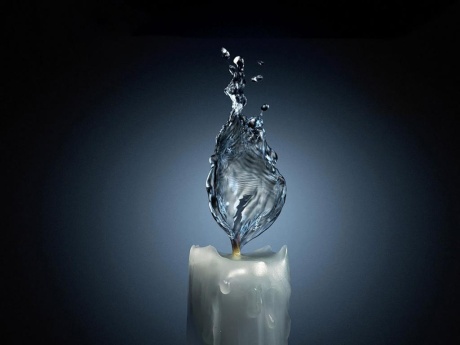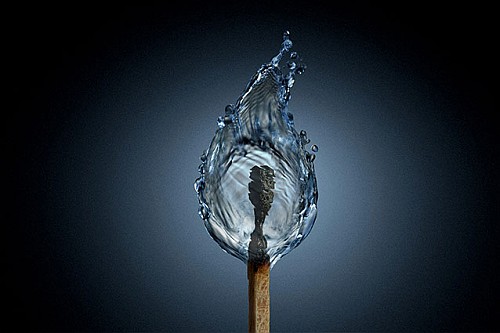|
|
|
| Строка 1: |
Строка 1: |
| - | '''[[Image:Img-wallpapers-candle-light water-priyadarsh-sarwade-77691.jpg|400px]]''' | + | '''<br>''' |
| | | | |
| - | <br> '''Background For Teachers:'''<br>The purpose of this activity is to help students discover the actual locations that hold water as it passes through the water cycle. The whole process begins with the sun. It is the sun’s heat that causes evaporation to occur. Water changes fr om its liquid state, like an ocean, and becomes an invisible vapor that rises. As the water condenses, we see it as clouds in the atmosphere. Depending on the temperature, humidity and other factors, the water can form different types of precipitation such as rain, snow, or hail. This water then collects in streams, rivers, lakes, and oceans. Some water also seeps into the ground and collects there. Water is also found in its solid state in the form of glaciers, near the polar regions of Earth and in snowpack conditions of high elevations for portions of the year.<br><br>'''Intended Learning Outcomes:'''<br>2. Manifest Scientific Attitudes and Interests<br>4. Communicate Effectively Using Science Language and Reasoning<br><br>'''Instructional Procedures:'''<br><br>'''Invitation to Learn'''<br>Ask: Have you ever taken a cold drink of water and wondered where it came from? Wh ere do you think it came from? How did it get to our school?<br><br>'''Instructional Procedures'''<br>Read a sample narrative story about a droplet of water (e.g., The Drop of Water, by Donald R. Daugs in The Comprehensive Water Education Book).<br>Distribute maps of Utah.<br>Discuss major lakes, rivers, and mountain ranges found close to the school.<br>Distribute journals or writing paper.<br>Have the students write a story about how a drop of water may have traveled to arrive at the school. The story should include specific names of mountains, lakes, and rivers it could have been held in.<br>Use their science journal pages to design a six-frame template for a presentation on the water cycle.<br>Assign the students to write in the following titles for each frame: Title, The Sun, Evaporation, Condensation, Precipitation, Collection.<br>Have the students illustrate each frame. This can be done with any media available.<br><br>[[Image:Voda spichka.jpeg|400px]]<br><br>'''Extensions:'''<br>Students could do another water story with a setting in another part of the world, such as Japan or China.<br>A water story could be prepared in advance with blanks for students to fill in the names of the mountains, oceans, rivers, etc.<br>Students with computer access could design a multimedia presentation of the water cycle or their water story.<br><br>'''Family Connections'''<br>Use a digital or 35 mm camera to take pictures of the sun (use caution when viewing the sun), clouds, mountains, lakes, rivers, etc. These can be assembled in a water cycle poster or made into a multimedia presentation.<br>Find out ways that you can help conserve water in your community and at home.<br>Take a family fieldtrip to the local water treatment plant or water storage facilities. <br><br>'''Assessment Plan:'''<br>The stories that the students write can be collected and evaluated.<br>The six-frame presentation design can be assessed.<br> | + | *'''[http://school.xvatit.com/index.php?title=Hypermarket_of_knowledge_-_the_first_in_the_world! Hypermarket of knowledge]<br>''' |
| | + | *'''[http://school.xvatit.com/index.php?title=Main_rivers Basic lesson]<br>''' |
| | + | *'''[http://school.xvatit.com/index.php?title=Main_rivers._Complete_lesson Complete lesson]<br>''' |
| | + | *'''[http://school.xvatit.com/index.php?title=Main_rivers._Illustrations Illustrations]<br>''' |
| | + | *'''[http://school.xvatit.com/index.php?title=Top_10_Exercises_to_get_fit_in_Water Exercises]<br>''' |
| | + | *'''[http://school.xvatit.com/index.php?title=The_lesson_outline_on_the_subject_%E2%80%9CRivers_of_Ukraine%E2%80%9D Summary]<br>''' |
| | + | *'''[http://school.xvatit.com/index.php?title=The_Water_Cycle_Model Accelerating methods]<br>''' |
| | + | *'''[http://school.xvatit.com/index.php?title=Water_World_Story Locked exercises]<br>''' |
| | + | *'''[http://school.xvatit.com/index.php?title=Video_practical_work_on_the_subject_%E2%80%9CPaint_the_river_of_your_dream_-_bright_and_colored_one%E2%80%9D Practical tasks]<br>''' |
| | + | *'''[http://school.xvatit.com/index.php?title=Creative_home_assignment_on_the_subject_%E2%80%9CProtection_of_rivers%E2%80%9D Home tasks]<br>''' |
| | + | *'''[http://school.xvatit.com/index.php?title=How_Water_Works Essay]<br>''' |
| | + | *'''[http://school.xvatit.com/index.php?title=The_Water_Cycle Stuff for curious]<br>''' |
| | + | *'''[http://school.xvatit.com/index.php?title=Legend_about_origin_of_rivers Interesting]<br>''' |
| | + | *'''[http://school.xvatit.com/index.php?title=Save_Water_Slogans Thematic holidays]<br>''' |
| | + | *'''[http://school.xvatit.com/index.php?title=Dnieper_River._Article Articles]<br>''' |
| | + | *'''[http://school.xvatit.com/index.php?title=The_vocabulary_of_demonic_symbolism_on_the_subject_%E2%80%9CWater_elements%E2%80%9D Fairy-tale terminology]''' |
| | + | *[http://school.xvatit.com/index.php?title=Seven_Suspicious_Water_Claims ''''Other'''''<b>'</b>''] |
| | + | |
| | + | <br> |
| | + | |
| | + | '''[[Image:Img-wallpapers-candle-light water-priyadarsh-sarwade-77691.jpg|400px|Img-wallpapers-candle-light water-priyadarsh-sarwade-77691.jpg]]''' |
| | + | |
| | + | <br> '''Background For Teachers:'''<br>The purpose of this activity is to help students discover the actual locations that hold water as it passes through the water cycle. The whole process begins with the sun. It is the sun’s heat that causes evaporation to occur. Water changes fr om its liquid state, like an ocean, and becomes an invisible vapor that rises. As the water condenses, we see it as clouds in the atmosphere. Depending on the temperature, humidity and other factors, the water can form different types of precipitation such as rain, snow, or hail. This water then collects in streams, rivers, lakes, and oceans. Some water also seeps into the ground and collects there. Water is also found in its solid state in the form of glaciers, near the polar regions of Earth and in snowpack conditions of high elevations for portions of the year.<br><br>'''Intended Learning Outcomes:'''<br>2. Manifest Scientific Attitudes and Interests<br>4. Communicate Effectively Using Science Language and Reasoning<br><br>'''Instructional Procedures:'''<br><br>'''Invitation to Learn'''<br>Ask: Have you ever taken a cold drink of water and wondered where it came from? Wh ere do you think it came from? How did it get to our school?<br><br>'''Instructional Procedures'''<br>Read a sample narrative story about a droplet of water (e.g., The Drop of Water, by Donald R. Daugs in The Comprehensive Water Education Book).<br>Distribute maps of Utah.<br>Discuss major lakes, rivers, and mountain ranges found close to the school.<br>Distribute journals or writing paper.<br>Have the students write a story about how a drop of water may have traveled to arrive at the school. The story should include specific names of mountains, lakes, and rivers it could have been held in.<br>Use their science journal pages to design a six-frame template for a presentation on the water cycle.<br>Assign the students to write in the following titles for each frame: Title, The Sun, Evaporation, Condensation, Precipitation, Collection.<br>Have the students illustrate each frame. This can be done with any media available.<br><br>[[Image:Voda spichka.jpeg|400px|Voda spichka.jpeg]]<br><br>'''Extensions:'''<br>Students could do another water story with a setting in another part of the world, such as Japan or China.<br>A water story could be prepared in advance with blanks for students to fill in the names of the mountains, oceans, rivers, etc.<br>Students with computer access could design a multimedia presentation of the water cycle or their water story.<br><br>'''Family Connections'''<br>Use a digital or 35 mm camera to take pictures of the sun (use caution when viewing the sun), clouds, mountains, lakes, rivers, etc. These can be assembled in a water cycle poster or made into a multimedia presentation.<br>Find out ways that you can help conserve water in your community and at home.<br>Take a family fieldtrip to the local water treatment plant or water storage facilities. <br><br>'''Assessment Plan:'''<br>The stories that the students write can be collected and evaluated.<br>The six-frame presentation design can be assessed.<br> |
| | | | |
| | [[Category:Main_river_basins_and_their_characteristics._Locked_exercises(for_teachers_only)]] | | [[Category:Main_river_basins_and_their_characteristics._Locked_exercises(for_teachers_only)]] |
Текущая версия на 13:22, 11 июля 2011

Background For Teachers:
The purpose of this activity is to help students discover the actual locations that hold water as it passes through the water cycle. The whole process begins with the sun. It is the sun’s heat that causes evaporation to occur. Water changes fr om its liquid state, like an ocean, and becomes an invisible vapor that rises. As the water condenses, we see it as clouds in the atmosphere. Depending on the temperature, humidity and other factors, the water can form different types of precipitation such as rain, snow, or hail. This water then collects in streams, rivers, lakes, and oceans. Some water also seeps into the ground and collects there. Water is also found in its solid state in the form of glaciers, near the polar regions of Earth and in snowpack conditions of high elevations for portions of the year.
Intended Learning Outcomes:
2. Manifest Scientific Attitudes and Interests
4. Communicate Effectively Using Science Language and Reasoning
Instructional Procedures:
Invitation to Learn
Ask: Have you ever taken a cold drink of water and wondered where it came from? Wh ere do you think it came from? How did it get to our school?
Instructional Procedures
Read a sample narrative story about a droplet of water (e.g., The Drop of Water, by Donald R. Daugs in The Comprehensive Water Education Book).
Distribute maps of Utah.
Discuss major lakes, rivers, and mountain ranges found close to the school.
Distribute journals or writing paper.
Have the students write a story about how a drop of water may have traveled to arrive at the school. The story should include specific names of mountains, lakes, and rivers it could have been held in.
Use their science journal pages to design a six-frame template for a presentation on the water cycle.
Assign the students to write in the following titles for each frame: Title, The Sun, Evaporation, Condensation, Precipitation, Collection.
Have the students illustrate each frame. This can be done with any media available.

Extensions:
Students could do another water story with a setting in another part of the world, such as Japan or China.
A water story could be prepared in advance with blanks for students to fill in the names of the mountains, oceans, rivers, etc.
Students with computer access could design a multimedia presentation of the water cycle or their water story.
Family Connections
Use a digital or 35 mm camera to take pictures of the sun (use caution when viewing the sun), clouds, mountains, lakes, rivers, etc. These can be assembled in a water cycle poster or made into a multimedia presentation.
Find out ways that you can help conserve water in your community and at home.
Take a family fieldtrip to the local water treatment plant or water storage facilities.
Assessment Plan:
The stories that the students write can be collected and evaluated.
The six-frame presentation design can be assessed.
Subjects > Geography > Geography 8th grade > Main river basins and their characteristics > Main river basins and their characteristics. Locked exercises(for teachers only)
|












